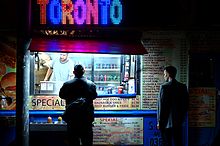
A food swamp is an urban environment with few grocery stores but several non-nutritious food options such as corner stores or fast-food restaurants. One definition gives a general ratio of four unhealthy options for each healthy option.[1] The term was first coined by researchers conducting longitudinal studies of the link between increased access to grocery stores and rising obesity rates.[2] Rose and colleagues in this study found that even with a new access to local grocery stores, the proportion of convenience stores and fast food to a single grocery store did not shift food choices nor obesity rates. This indicates that food swamps are separate from food deserts.
The concept is comparable to that of a food desert. Those in a food desert have poor local access to nutritious food sources; those in a food swamp have easy local access to non-nutritious food.[3] According to researchers, food swamps are better measures for obesity rates.[4] One of the factors that may better explain this phenomenon is the surrounding neighborhood of a food swamp; researchers found that a large portion of the community do not use public transportation as their primary commute. This means that food options are still severely limited, especially when the nearest convenience store, bodega, or fast food restaurant is at walking distance and consumes the least amount of time. Differential barriers of low-income communities are mentioned as important influences on food swamp characterization.[4]
- ^ Khazan, Olga (2017-12-28). "Food Swamps Are the New Food Deserts". The Atlantic. Retrieved 2022-03-28.
- ^ Rose, Donald; Bodor, J. Nicholas; Rice, Janet C.; Swalm, Chris M.; Hutchinson, Paul L. (2011). "The Effects of Hurricane Katrina on Food Access Disparities in New Orleans". American Journal of Public Health. 101 (3): 482–484. doi:10.2105/ajph.2010.196659. ISSN 0090-0036. PMC 3036701. PMID 21233432.
- ^ Canada, Health (9 October 2013). "Measuring the Food Environment in Canada". www.canada.ca. Retrieved 1 July 2023.
- ^ a b Cooksey-Stowers, Kristen; Schwartz, Marlene; Brownell, Kelly (2017-11-14). "Food Swamps Predict Obesity Rates Better Than Food Deserts in the United States". International Journal of Environmental Research and Public Health. 14 (11): 1366. doi:10.3390/ijerph14111366. ISSN 1660-4601. PMC 5708005. PMID 29135909.
© MMXXIII Rich X Search. We shall prevail. All rights reserved. Rich X Search
